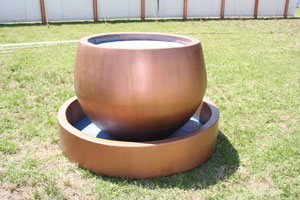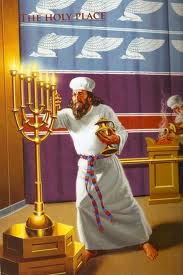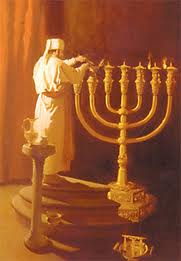Take Apart Tabernacle
The murmurings of the Israelites and the visitations of God's judgments because of their sins are recorded as a warning to after-generations. And their devotion, their zeal and liberality, are an example worthy of imitation. All who love the worship of God and prize the blessing of His sacred presence will manifest the same spirit of sacrifice in preparing a house where He may meet with them. They will desire to bring to the Lord an offering of the very best that they possess. A house built for God should not be left in debt, for He is thereby dishonored. An amount sufficient to accomplish the work should be freely given, that the workmen may be able to say, as did the builders of the tabernacle, "Bring no more offerings."
The tabernacle was so constructed that it could be taken apart and borne with the Israelites in all their journeyings. It was therefore small, being not more than fifty-five feet in length, and eighteen in breadth and height. Yet it was a magnificent structure. The wood employed for the building and its furniture was that of the acacia tree, which was less subject to decay than any other to be obtained at Sinai. The walls consisted of upright boards, set in silver sockets, and held firm by pillars and connecting bars; and all were overlaid with gold, giving to the building the appearance of solid gold. The roof was formed of four sets of curtains, the innermost of "fine twined linen, and blue, and purple, and scarlet: with cherubim of cunning work;" the other three respectively were of goats' hair, rams' skins dyed red, and sealskins, so arranged as to afford complete protection.
The building was divided into two apartments by a rich and beautiful curtain, or veil, suspended from gold-plated pillars; and a similar veil closed the entrance of the first apartment. These, like the inner covering, which formed the ceiling, were of the most gorgeous colors, blue, purple, and scarlet, beautifully arranged, while inwrought with threads of gold and silver were cherubim to represent the angelic host who are connected with the work of the heavenly sanctuary and who are ministering spirits to the people of God on earth.
The sacred tent was enclosed in an open space called the court, which was surrounded by hangings, or screens, of fine linen, suspended from pillars of brass. The entrance to this enclosure was at the eastern end. It was closed by curtains of costly material and beautiful workmanship, though inferior to those of the sanctuary. The hangings of the court being only about half as high as the walls of the tabernacle, the building could be plainly seen by the people without. In the court, and nearest the entrance, stood the brazen altar of burnt offering. Upon this altar were consumed all the sacrifices made by fire unto the Lord, and its horns were sprinkled with the atoning blood. Between the altar and the door of the tabernacle was the laver, which was also of brass, made from the mirrors that had been the freewill offering of the women of Israel.

At the laver the priests were to wash their hands and their feet whenever they went into the sacred apartments, or approached the altar to offer a burnt offering unto the Lord.

In the first apartment, or holy place, were the table of showbread, the candlestick, or lampstand, and the altar of incense. The table of showbread stood on the north. With its ornamental crown, it was overlaid with pure gold. On this table the priests were each Sabbath to place twelve cakes, arranged in two piles, and sprinkled with frankincense. The loaves that were removed, being accounted holy, were to be eaten by the priests. On the south was the seven-branched candlestick, with its seven lamps. Its branches were ornamented with exquisitely wrought flowers, resembling lilies, and the whole was made from one solid piece of gold. There being no windows in the tabernacle, the lamps were never all extinguished at one time, but shed their light by day and by night. Just before the veil separating the holy place from the most holy and the immediate presence of God, stood the golden altar of incense. Upon this altar the priest was to burn incense every morning and evening; its horns were touched with the blood of the sin offering, and it was sprinkled with blood upon the great Day of Atonement. The fire upon this altar was kindled by God Himself and was sacredly cherished. Day and night the holy incense diffused its fragrance throughout the sacred apartments, and without, far around the tabernacle.

Beyond the inner veil was the holy of holies, where centered the symbolic service of atonement and intercession, and which formed the connecting link between heaven and earth. In this apartment was the ark, a chest of acacia wood, overlaid within and without with gold, and having a crown of gold about the top. It was made as a depository for the tables of stone, upon which God Himself had inscribed the Ten Commandments. Hence it was called the ark of God's testament, or the ark of the covenant, since the Ten Commandments were the basis of the covenant made between God and Israel.
The cover of the sacred chest was called the mercy seat. This was wrought of one solid piece of gold, and was surmounted by golden cherubim, one standing on each end. One wing of each angel was stretched forth on high, while the other was folded over the body (see Ezekiel 1:11) in token of reverence and humility. The position of the cherubim, with their faces turned toward each other, and looking reverently downward toward the ark, represented the reverence with which the heavenly host regard the law of God and their interest in the plan of redemption.
Above the mercy seat was the Shekinah, the manifestation of the divine Presence; and from between the cherubim, God made known His will. Divine messages were sometimes communicated to the high priest by a voice from the cloud. Sometimes a light fell upon the angel at the right, to signify approval or acceptance, or a shadow or cloud rested upon the one at the left to reveal disapproval or rejection.
The law of God, enshrined within the ark, was the great rule of righteousness and judgment. That law pronounced death upon the transgressor; but above the law was the mercy seat, upon which the presence of God was revealed, and from which, by virtue of the atonement, pardon was granted to the repentant sinner. Thus in the work of Christ for our redemption, symbolized by the sanctuary service, "mercy and truth are met together; righteousness and peace have kissed each other." Psalm 85:10.
No language can describe the glory of the scene presented within the sanctuary--the gold-plated walls reflecting the light from the golden candlestick, the brilliant hues of the richly embroidered curtains with their shining angels, the table, and the altar of incense, glittering with gold; beyond the second veil the sacred ark, with its mystic cherubim, and above it the holy Shekinah, the visible manifestation of Jehovah's presence; all but a dim reflection of the glories of the temple of God in heaven, the great center of the work for man's redemption.
PP 347-349
